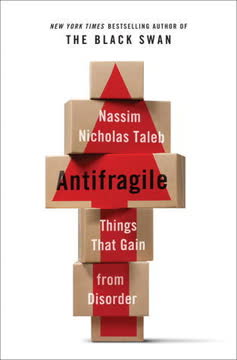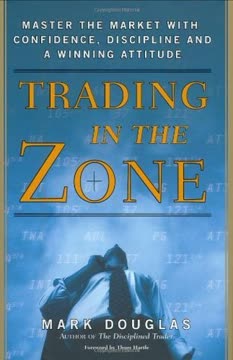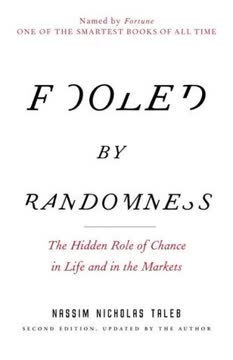Key Takeaways
1. Success can breed overconfidence and set you up for failure
Personalizing successes sets people up for disastrous failure.
The danger of success. When individuals experience a string of successes, they often attribute these wins to their own abilities rather than external factors or luck. This can lead to a false sense of invincibility and overconfidence in their decision-making abilities.
The Midas touch syndrome. People who have succeeded repeatedly may start to believe they have a "Midas touch" – that everything they touch will turn to gold. This mindset can cause them to take unnecessary risks or ignore warning signs in future endeavors.
Breaking rules without consequences. Success despite breaking rules can reinforce the belief that one is exempt from following established guidelines. This can lead to increasingly risky behavior and ultimately result in catastrophic losses when luck runs out.
2. Losses in the market are often due to psychological factors, not analytical ones
People lose (really lose, not just have occasional losing trades) because of psychological factors, not analytical ones.
Emotions over analysis. Many traders and investors possess the necessary analytical skills to make sound decisions, but their emotions often override their logical thinking. Fear, greed, and the need to be right can lead to poor decision-making and significant losses.
Cognitive biases. The human mind is susceptible to various cognitive biases that can distort rational thinking in market situations:
- Confirmation bias: Seeking information that confirms existing beliefs
- Anchoring bias: Relying too heavily on the first piece of information encountered
- Sunk cost fallacy: Continuing to invest in a losing position due to past investments
Overcoming psychological barriers. Successful traders and investors focus on developing emotional intelligence and self-awareness to recognize and mitigate these psychological factors. This often involves:
- Implementing strict risk management strategies
- Keeping a trading journal to identify emotional patterns
- Seeking objective feedback from trusted peers or mentors
3. Distinguish between external, objective losses and internal, subjective losses
External losses are objective and internal losses are subjective.
External losses. These are objective, quantifiable losses that can be measured in terms of money or other tangible assets. They are not open to interpretation and are the same for everyone involved.
Internal losses. These are subjective experiences that vary from person to person. They involve emotional reactions, personal interpretations, and psychological impact.
The danger of internalization. When traders internalize external losses, they begin to equate their self-worth with market performance. This can lead to:
- Emotional decision-making
- Inability to cut losses
- Increased risk-taking to "make up" for losses
- Psychological distress and burnout
4. Understand the five stages of internal loss to avoid emotional decision-making
The Five Stages of Internal Loss
The stages explained:
- Denial: Refusing to accept the reality of a loss
- Anger: Feeling frustrated and looking for someone or something to blame
- Bargaining: Attempting to negotiate or find a way out of the loss
- Depression: Experiencing sadness and hopelessness about the situation
- Acceptance: Finally coming to terms with the loss and its implications
Recognizing the stages. By understanding these stages, traders can identify when they are experiencing an internal loss and take steps to mitigate its impact on their decision-making.
Breaking the cycle. To avoid getting stuck in these stages:
- Set predetermined stop-loss levels and adhere to them strictly
- Practice emotional detachment from individual trades
- Focus on long-term performance rather than short-term results
- Seek support from trusted colleagues or mentors when struggling with losses
5. Recognize the difference between inherent and created risk in market activities
Created risk involves the arbitrary invention of a potential monetary loss which otherwise would not have existed.
Inherent risk. This is the natural risk associated with market participation, such as:
- Economic fluctuations
- Company performance
- Geopolitical events
Created risk. This is additional risk introduced by the participant through:
- Excessive leverage
- Gambling-like behavior
- Emotional decision-making
Behavioral characteristics. The type of risk a person engages in is determined by their behavior, not the activity itself:
- Investing: Focusing on long-term growth and income
- Trading: Market-making and extracting bid-ask spreads
- Speculating: Seeking capital appreciation based on market analysis
- Betting: Attempting to be right about market outcomes
- Gambling: Seeking excitement and entertainment from market participation
6. Avoid becoming part of the psychological crowd in market decision-making
When the sentiments and ideas of all the people in the gathering take one and the same direction and their conscious individual personality disappears, then the gathering has become a psychological crowd.
Characteristics of crowd behavior:
- Sentiment of invincible power
- Contagion of emotions and ideas
- Heightened suggestibility
Individual crowd behavior. Even isolated individuals can exhibit crowd-like behavior in their market decisions by:
- Being swayed by every news story or price change
- Making impulsive, emotion-driven decisions
- Seeking validation from others for their market views
Maintaining individuality. To avoid becoming part of the crowd:
- Develop and stick to a personal trading plan
- Limit exposure to constant market news and chatter
- Practice independent thinking and analysis
- Seek out diverse perspectives and challenge your own assumptions
7. Develop and stick to a well-defined plan to maintain objectivity in trading
Participating in the markets is about decision-making implemented by a plan.
Elements of a successful plan:
- Clear entry and exit criteria
- Predetermined risk management rules
- Specific analysis methods and tools
- Defined time horizons for investments or trades
The importance of writing it down. Committing your plan to paper:
- Objectifies and externalizes your thinking
- Allows for easier self-accountability
- Provides a clear reference during emotional market times
Maintaining discipline. Sticking to your plan:
- Removes emotional decision-making from the equation
- Ensures consistent application of your strategy
- Allows for objective evaluation and improvement of your approach over time
Continuous improvement. Regularly review and refine your plan based on:
- Market performance
- Changes in personal goals or risk tolerance
- New information or analytical tools
- Lessons learned from both successes and failures
Last updated:
FAQ
What's "What I Learned Losing a Million Dollars" about?
- Personal Story of Loss: The book is a personal account by Jim Paul, detailing his journey from success to a devastating financial loss in the markets.
- Psychological Insights: It explores the psychological dynamics of losing money and how personal ego and emotions can lead to financial disaster.
- Lessons from Failure: The narrative is used as a parable to illustrate broader lessons about risk management and decision-making in trading and investing.
- Co-authored Perspective: Brendan Moynihan contributes to the analysis, providing a broader context and additional insights into the psychological aspects of trading.
Why should I read "What I Learned Losing a Million Dollars"?
- Unique Perspective: It offers a rare insight into the personal and psychological aspects of financial loss, which is often overlooked in trading literature.
- Practical Lessons: The book provides practical advice on how to avoid common psychological pitfalls in trading and investing.
- Relatable Story: Jim Paul's story is engaging and relatable, making complex psychological concepts easier to understand.
- Broad Applicability: The lessons extend beyond trading, offering valuable insights for anyone involved in decision-making under uncertainty.
What are the key takeaways of "What I Learned Losing a Million Dollars"?
- Ego and Loss: Personalizing successes and failures can lead to disastrous financial decisions.
- Psychological Stages: Understanding the five stages of internal loss can help prevent emotional decision-making.
- Importance of a Plan: Having a clear plan with predefined exit strategies is crucial to managing risk.
- Diverse Methods: There are many ways to make money in the markets, but controlling losses is more important than finding the perfect method.
What are the best quotes from "What I Learned Losing a Million Dollars" and what do they mean?
- "Success can be built upon repeated failures when the failures aren’t taken personally." This highlights the importance of learning from mistakes without letting them affect your self-worth.
- "The majority of unskilled investors stubbornly hold onto their losses when the losses are small and reasonable." It emphasizes the need to cut losses early to prevent them from escalating.
- "Participating in markets is not about being right or wrong, nor is it about defeat; it’s about making decisions." This underscores the importance of objective decision-making over emotional reactions.
- "A plan allows you to speculate with a long time horizon (as an investor), a short time horizon (as a trader) or on a spread relationship (as a basis trader or hedger)." It stresses the necessity of having a structured approach to trading.
How does Jim Paul describe his journey in "What I Learned Losing a Million Dollars"?
- Early Success: Jim Paul describes his rapid rise from a country boy to a successful trader and member of the Chicago Mercantile Exchange.
- Spectacular Loss: He recounts the series of events and decisions that led to a $1.6 million loss in just 75 days.
- Psychological Impact: The narrative delves into the emotional and psychological impact of his financial downfall.
- Learning from Failure: Paul uses his story to illustrate the broader lessons he learned about risk management and decision-making.
What psychological concepts are explored in "What I Learned Losing a Million Dollars"?
- Five Stages of Internal Loss: The book outlines denial, anger, bargaining, depression, and acceptance as stages people go through when facing a loss.
- Ego Involvement: It discusses how personalizing market positions can lead to emotional decision-making and financial loss.
- Crowd Behavior: The book examines how individuals can become part of a psychological crowd, leading to irrational trading decisions.
- Hope/Fear Paradox: It explores the dual emotions of hope and fear and their impact on trading behavior.
What advice does "What I Learned Losing a Million Dollars" offer for managing risk?
- Have a Plan: Develop a detailed plan with predefined entry and exit points to manage risk effectively.
- Control Losses: Focus on controlling losses rather than trying to predict profits.
- Avoid Emotional Decisions: Recognize and avoid emotional decision-making by understanding the psychological dynamics of loss.
- Diversify Approaches: Understand that there are many ways to make money in the markets, but controlling losses is paramount.
How does "What I Learned Losing a Million Dollars" differentiate between investing, speculating, and gambling?
- Investing: Defined as parting with capital for safety and adequate return over a long time horizon.
- Speculating: Involves buying for resale with the expectation of capital appreciation, not for income.
- Gambling: Described as wagering money on chance events for entertainment, not for financial gain.
- Behavioral Characteristics: The book emphasizes that the activity is defined by the participant's behavior, not the activity itself.
What role does ego play in financial decision-making according to "What I Learned Losing a Million Dollars"?
- Ego and Success: Personalizing successes can inflate ego, leading to overconfidence and poor decision-making.
- Ego and Loss: When losses are personalized, individuals may refuse to accept them, leading to larger financial disasters.
- Objective Decision-Making: The book stresses the importance of separating ego from financial decisions to maintain objectivity.
- Ego as a Barrier: Ego can prevent individuals from acknowledging mistakes and learning from them.
How does "What I Learned Losing a Million Dollars" address the concept of emotionalism in trading?
- Emotionalism Defined: Emotionalism is decision-making based on emotions rather than objective analysis.
- Crowd Behavior: The book explains how individuals can become part of a psychological crowd, leading to emotional decisions.
- Hope and Fear: It discusses the paradox of hope and fear and their simultaneous impact on trading behavior.
- Avoiding Emotionalism: The book advises using a structured plan to impose discipline and avoid emotional decision-making.
What lessons does "What I Learned Losing a Million Dollars" offer for entrepreneurs and business leaders?
- Avoid Personalization: Do not equate personal worth with business success or failure to avoid emotional decision-making.
- Plan for Losses: Develop a clear plan with exit strategies to manage risk effectively.
- Learn from Mistakes: Use failures as learning opportunities without letting them affect self-esteem.
- Objective Decision-Making: Maintain objectivity in decision-making by separating ego from business outcomes.
How does "What I Learned Losing a Million Dollars" suggest dealing with uncertainty in the markets?
- Speculation as Planning: Treat speculation as a form of planning, with thought and analysis preceding action.
- Scenario Planning: Use scenario planning to evaluate potential outcomes and prepare for different market conditions.
- Focus on Losses: Concentrate on managing potential losses rather than predicting profits.
- Structured Approach: Implement a structured approach with predefined rules and exit strategies to navigate uncertainty.
Review Summary
What I Learned Losing a Million Dollars is praised for its candid approach to financial losses and psychological factors in investing. Readers appreciate its focus on avoiding catastrophic losses rather than providing a winning system. The book's autobiographical first half receives mixed reactions, with some finding it entertaining and others tedious. Many readers value the insights on market psychology, risk management, and the importance of having a well-defined plan. The book is frequently recommended for both novice and experienced investors, with several noting its enduring relevance despite being published decades ago.
Similar Books










Download PDF
Download EPUB
.epub digital book format is ideal for reading ebooks on phones, tablets, and e-readers.




